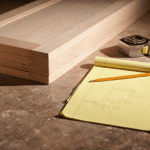
From the cozy warmth of a log cabin in winter to the creak of a wooden porch on a hot summer day, wood is an essential material in our daily lives. But have you ever stopped to think about how the changing seasons might be influencing your wooden possessions? Just like our skin can feel the effects of dry winter air or the heavy humidity of summer, wood too reacts to these environmental changes. This article explores the fascinating relationship between wood and the seasonal shifts in humidity and temperature.
Understanding Wood: A Living Material
At first glance, it might seem odd to think of wood as ‘living’. After all, once a tree is cut down, it’s no longer growing, right? While that’s true, the cells inside the wood continue to react to their surroundings. Wood is hygroscopic, meaning it naturally absorbs and releases moisture from the surrounding air. This ongoing interaction is what causes wood to expand or contract.
Temperature: More Than Just Hot or Cold
Temperature plays a fundamental role in how wood behaves. When wood is subjected to high temperatures, its moisture evaporates more quickly. This can cause the wood to become drier and more brittle. On the other hand, cold conditions can slow down the evaporation process, making the wood retain its moisture. But temperature alone isn’t the sole factor – humidity plays a significant role as well.
Humidity: The Invisible Force
Imagine a summer day – one moment the sun is shining, and the next, it’s raining. This rapid change in weather showcases the dramatic shifts in humidity levels we can experience. Humidity, simply put, is the amount of moisture present in the air. High humidity means there’s a lot of moisture in the air, while low humidity means the opposite.
For wood, high humidity can be a challenge. When the air is saturated with moisture, wood absorbs some of this water, causing it to expand. Conversely, during low humidity conditions, wood releases its moisture to the dry air, leading it to shrink. This expanding and contracting can sometimes lead to warping, cracking, or other structural changes in the wood.

Practical Implications: From Furniture to Flooring
The effects of temperature and humidity on wood have practical implications for everyday life. If you’ve ever noticed a wooden door sticking during a particularly humid day or seen gaps in hardwood floors during dry winter months, you’ve witnessed these changes firsthand.
To ensure the longevity of wooden items, it’s essential to consider the environment in which they are placed. For example:
- When buying wooden furniture or flooring, it’s beneficial to know the wood’s origin. Wood that’s native to high humidity regions might not fare as well in drier climates without proper care.
- Use of humidifiers during winter and dehumidifiers during summer can help maintain a consistent level of moisture in the air, benefiting both your wooden possessions and overall comfort.
- Applying sealants or finishes to wood can act as a barrier, minimizing the direct effects of humidity and temperature changes.
The Science Behind the Shifts
To delve deeper into the world of wood, let’s examine the science behind these seasonal shifts. Each piece of wood has what experts call a ‘fiber saturation point’. This term refers to the maximum amount of water the cell walls of wood can hold without the water filling the cell cavities. When wood is in equilibrium with the surrounding air’s humidity, it won’t gain or lose any more moisture. This balanced state is referred to as the ‘equilibrium moisture content’ or EMC.
Daily Rhythms and Seasonal Shifts
While we often consider seasonal changes, it’s essential to remember that temperature and humidity can fluctuate daily. The early morning dew or the dampness after a summer storm can have immediate, albeit temporary, impacts on wood. This daily dance can sometimes be more pronounced than the longer, gradual shifts of the seasons.
Tips for Preserving Wood’s Integrity
Given the susceptibility of wood to environmental factors, it’s important to consider proactive steps to maintain its structural and aesthetic integrity:
- Regular Inspection: Regularly inspect wooden structures, especially those exposed to the elements like decks or outdoor furniture. Check for signs of warping, swelling, or cracking.
- Proper Storage: If storing wooden items like instruments or antiques, choose a location with consistent temperature and humidity. Avoid places like basements or attics where these conditions can vary widely.
- Protection from Direct Elements: If possible, shield wooden structures from direct sunlight, rain, or snow using shades, covers, or other protective measures.
- Know Your Wood: Different types of wood respond differently to environmental conditions. Hardwoods like oak or maple typically react less dramatically to humidity changes than softwoods like pine or cedar.

Conclusion
Wood’s sensitivity to the changing seasons is a testament to its organic nature. By understanding the relationship between wood and the environment, we can better appreciate its beauty and take measures to ensure its longevity. As we welcome each season’s unique charm, let’s also embrace the ever-adaptive dance of wood, shifting in harmony with the world around it. Remember, with a little care and knowledge, the wooden treasures in our lives can be preserved for many seasons to come.






